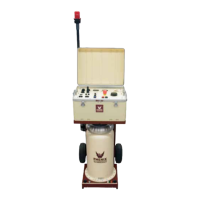BK-130
4-2
INITIAL SET-UP--ELECTRICAL
The following are examples of basic setups for performing various tests using the PHENIX test set.
Refer to the A92.2 standard (Included in optional accessory package) for test parameters and for more
detailed information.
Connections for testing Categories A & B Aerial Devices
(Refer to Figure 4-1):
1. Connect the ground stud on the high voltage transformer to a good earth ground using the supplied
lead.
2. Connect the ground stud on the high voltage transformer to the ground stud on the control cabinet
using the supplied lead.
3. Connect the HV (130kV) output terminal on top of the high voltage transformer to the bucket of the
truck under test using a piece of wire (Included in the optional accessory package). Verify that all
metal in the bucket is bonded together and connected to the high voltage lead using bus wire or clip
leads (Included in the optional accessory package). Make sure that the tap selector switch on the
front panel is in the 130kV position.
4. Connect the RETURN terminal at the base of the high voltage transformer to the meter receptacle on
the boom using a coaxial lead (Included in the optional accessory package).
5. Connect the power connector on the high voltage transformer to the mating connector on the control
cabinet using the supplied cable.
6. Connect the control/metering connector on the high voltage transformer to the mating connector on
the control cabinet using the supplied cable.
7. Connect input power cable to controls. Do not connect to power source until setup is complete.
8. This connector has a jumper installed that can be removed to connect an external safety switch
(Included in the optional accessory package).
9. Connect the GND terminal at the base of the high voltage transformer to the chassis of the truck.
NOTE: Other jumpers to bypass chassis insulators, pivot points, knuckles, joints etc. are usually required.
WARNING:
Ground the output of the High Voltage Transformer until set-up is complete! Be sure the Main
Power Circuit Breaker is in the OFF position before proceeding. This equipment should only be
operated by personnel familiar with High Voltage Testing and Safety Procedures

